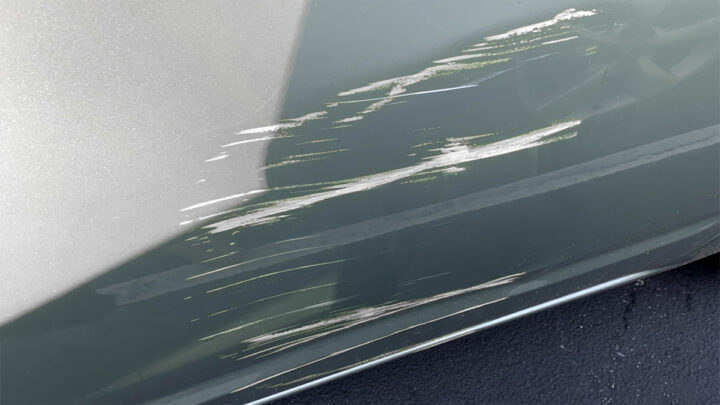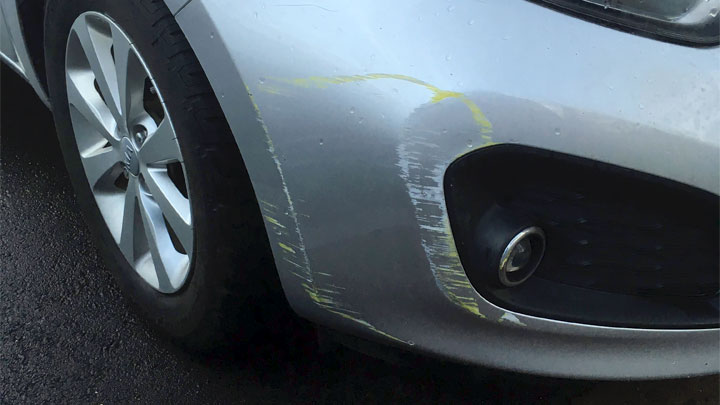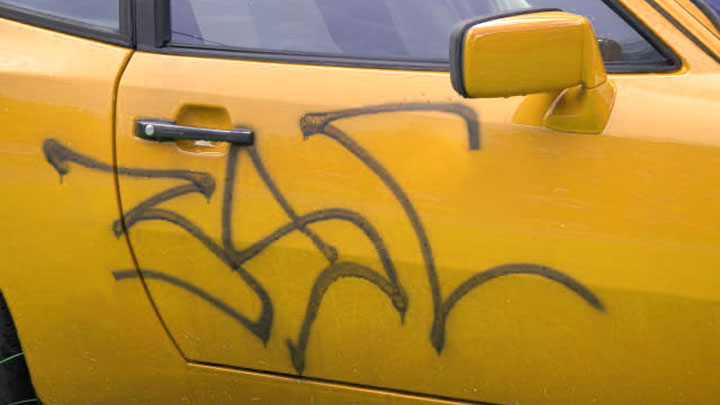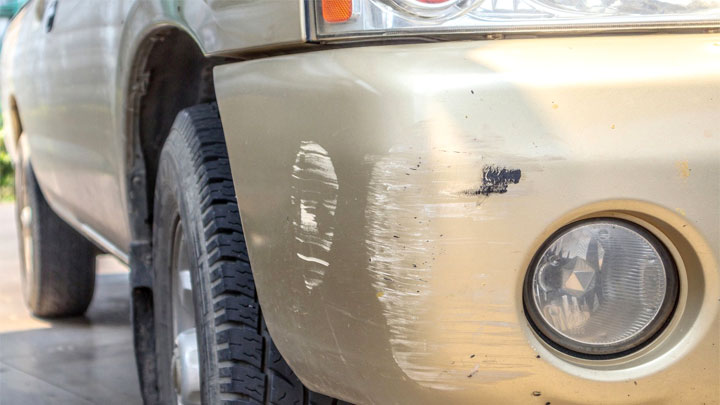How to Remove Paint Scuffs (Paint Transfer) From Your Car
Perfectly polished paint makes a vehicle shine, but keeping that flawless finish can be quite the chore. When paint scuffs or transfers mar the surface, quick fixes may do more harm than good. With so many DIY tips circulating online, it’s tough to know fact from fiction.
To find the removal methods preferred by professionals today and separate “junk science” from genuine solutions, read on as we address the best practices for removal of paint scuffs and paint transfer.

See Also: How to Detail a Car Exterior (Comprehensive Guide)
What is Paint Transfer?
Paint Transfer is a term used to describe the swapping of paint from one painted surface to another, such as a vehicle’s bumper, often as the result of a collision.
While some of this transferred paint is easily wiped away in most cases, it is not uncommon for a certain amount of paint to be left behind. This can be quite unsightly, and frustrating to contend with.
As stated above, paint scuffs or transfer most commonly results from a collision between a vehicle, and another painted surface. This can be another vehicle, a pole, or even a paired retaining wall. Additionally, the color of paint transferred to a vehicle often helps discern what, exactly, was struck.
Identifying the Severity of the Paint Scuff

One of the first steps to removing paint scuffs is determining the severity of the scuff that is to be treated. Like any form of cosmetic damage, some paint scuffs are far worse than others, requiring a somewhat different approach for removal. Because of this, care must be taken when determining the depth and scope of the scuff that is to be addressed.
Generally speaking, a paint scuff can be categorized into one of three different categories; minor, moderate, or deep/severe.
Minor Paint Transfer
Minor paint scuffs are those that are relatively minor in nature, only minimally penetrating a vehicle’s clear coat. In many cases, a noticeable amount of the embedded paint can be removed by simply wiping with a damp cloth.
Scuffs of this nature are also typically shallow enough that they will not snag a motorist’s finger nail, when they are evaluated by hand. Most scuffs of this severity are easily removed.
Moderate Painter Transfer
Moderate paint scuffs are noticeably deeper than those mentioned above, often penetrating the majority of the way through a vehicle’s clear coat, or even into the base paint itself.
These scuffs can be readily felt by hand, and will typically snag one’s finger nail when assessed. Foreign paint deposited in this manner is not easily wiped away, and requires a noteworthy degree of TLC to remove.
Deep/Severe Paint Transfer
Severe paint scuffs are quite deep, often penetrating through a vehicle’s base layer of paint, even penetrating into the primer. In the most frustrating of cases, deep paint scuffs can even reach the base metal of a particular body panel.
Unfortunately, damage of this type is not simply wiped away, often proving difficult enough to remove that professional assistance is necessitated.
How to Get Paint Transfer Off a Car

The following procedure can be followed to assist you in the removal of paint transfer from your vehicle’s exterior. Best results are achieved when this damage is minor to moderate in nature, as severe scuffs and paint transfer is best treated in an alternate fashion.
#1 – Gather What’s Needed
Here are the items you’ll need to remove paint transfer from your car. We listed our favorites for each but feel free to use whatever brand you want.
- Hose/spray nozzle (Orbit Max)
- Quality auto body wash (Chemical Guys Citrus Wash or Meguiar’s Gold Class)
- Clay bar kit (Mothers 07240 Clay Bar System)
- Microfiber towel (Chemical Guys microfiber towels)
- Car wax (Chemical Guys Butter Wet Wax or Meguiar’s Ultimate Liquid Wax)
#2 – Clean Vehicle Thoroughly
Begin by thoroughly cleaning your vehicle with a quality automotive body wash. Rinse away all soapy residue and dry the vehicle with microfiber towels when finished.
#3 – Apply Detailing Lubricant
Spray a liberal amount of clay bar detailing lubricant (included in the kit above) on the spot that you wish to remove paint transfer from.
#4 – Work Surface With Clay Bar
Take your clay bar and gently work it within your hand to prepare it for use. Work the clay bar into the affected surface using a straight back and forth motion with very light pressure, watching for the transferred paint to be lifted.
#5 – Wipe and Assess
Next, with the use of a microfiber towel, you will wipe down the treated surface, ensuring that all transferred paint has been removed. If any paint remains, repeat steps #2-#3.
#6 – Seal Paint With Desired Treatment
After obtaining satisfactory results, proceed to treat all of your vehicle’s painted surfaces with a wax or sealant of your choice. Doing so will revitalize its natural luster, and ensure increased protection in the future.
Will This Work to Get Spray Paint or Graffiti Off My Car?

Much to the surprise of most motorists, the steps listed above will also work to remove graffiti and spray paint from painted surfaces in most cases. However, accomplishing this will take a fair amount of time, and can often prove tedious.
Nonetheless, your patience will be rewarded, as this method of removal proves far less risky than the use of chemicals, such as acetone or paint thinner.
Since clay bar is simply a synthetic resin, it will not damage your vehicle’s paint, even with moderately aggressive use. Therefore, there is little reason to hold back in your removal endeavors. Clay bar also contains no abrasive, so the chances of blemishing your vehicle’s paint is slim to none.
Other Ways to Remove Paint Scuffs
By now, most have heard of several off-the-cuff remedies for the removal of vehicle paint scuffs and many types of scratches. These makeshift methods of paint/scuff removal tend to experience widely varying degrees of success.
Of these home remedies, such as the use of WD-40 and rubbing alcohol, only a few hold true promise. Believe it or not, toothpaste can actually be used as a mild buffing agent, removing shallow scratches due to its slightly abrasive composition.
Those wishing to use home remedies of any type for removing paint scuffs and scratches from their vehicle should be extremely cautious. A number of remedies often cited for such uses can actually damage a vehicle’s paint under certain circumstances.
For example, the use of lacquer thinner can damage a vehicle’s clear coat, and often reacts unpredictably with automotive paint. Likewise other household cleaning products, such as magic erasers, are known to be overly abrasive for such uses, if not used carefully.
Read Also: Wrap vs Re-Paint (Which is Better?)
When to Call in the Pros

Both minor and moderate paint scuffs are managed relatively easily at home, assuming that you enough time and the correct tools at your disposal. However, scuffs that are deep or severe in nature are another thing entirely.
Deep scuffs or scratches often penetrate into, or beyond a vehicle’s clear coat, damaging actual base paint. When this occurs, it becomes far more difficult to repair or mask the damage that has been done.
As a general rule, it is always a good idea to seek professional assistance whenever a scratch of scuff is more than superficial in nature, harming more than a vehicle’s clear coat.
No amount of waxing, buffing, or polishing with add back base paint once it has been removed. Therefore, the repair of damage this complex is best left to professionals.
Preventing Future Paint Scuffs
If you’ve ever found yourself in the position of removing unsightly scratches from a vehicle, you have likely wondered how to prevent such damage from occurring in the first place. Luckily, there are a number of products currently available to accomplish this.
The vast majority of these products are of a ceramic composition. These products are meant to be sprayed on, and buffed into and onto the painted surfaces of any vehicle, preventing unnecessary damage from being done to such surfaces.
- 5 Symptoms of an EVAP Leak (and Repair Cost) - Apr 27, 2024
- P0480 Code (Symptoms, Causes, and How to Fix) - Apr 19, 2024
- Car Temperature Gauge Stopped Working? (Here’s Why) - Apr 15, 2024
